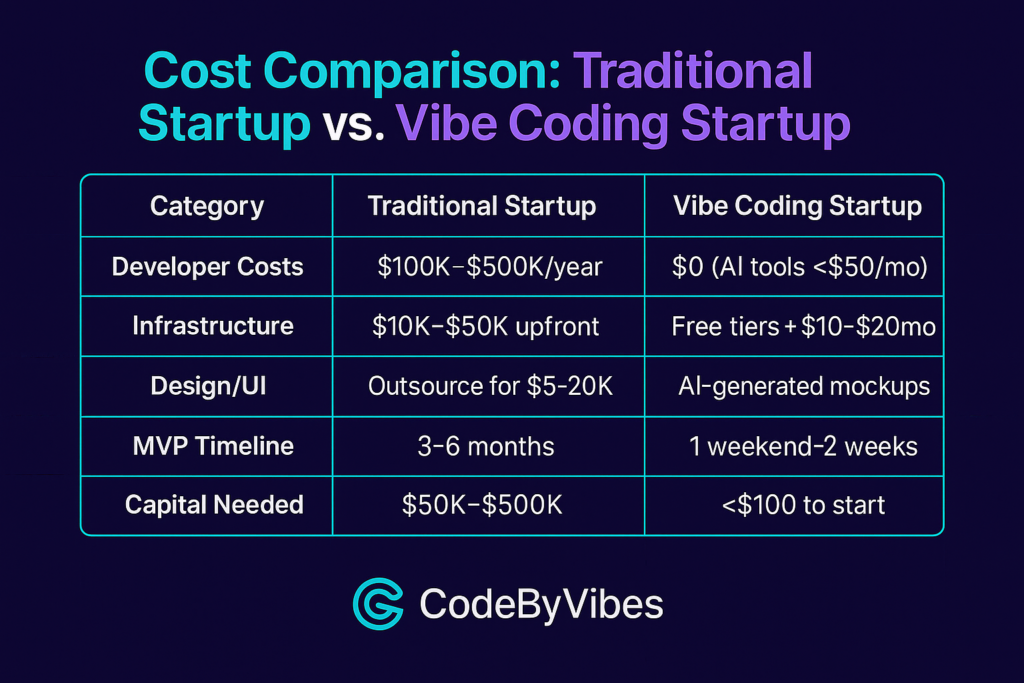The Economics of Vibe Coding: Building Startups With Almost Zero Capital
Introduction: The New Economics of Innovation
In the past, starting a software company required capital, teams, and months of development. You needed developers, designers, infrastructure, and funding before your idea even saw daylight.
But in 2025, vibe coding is rewriting those rules. With AI-powered tools, a solo creator can build an MVP, launch it, and test it — often in a single weekend — with little to no startup capital.
This shift isn’t just about technology. It’s about economics, accessibility, and the democratization of entrepreneurship.
1. The Old Model: Why Startups Used to Be Expensive
- Developer salaries: Skilled coders can cost six figures annually.
- Infrastructure costs: Servers, hosting, deployment pipelines.
- Time = money: Building a minimum viable product (MVP) often took months.
- Venture capital dependence: You needed investors to cover upfront costs.
💡 Key Takeaway: Traditional startup economics meant only a select few could take the risk of launching.
2. The Vibe Coding Revolution
As Cloudflare explains, vibe coding is “AI-assisted coding where natural language replaces syntax, allowing developers and non-developers to build software by describing their intent” .
This simple shift has massive economic consequences:
- No need to hire a team at day one.
- No upfront infrastructure costs (many tools host for free).
- No months of waiting — you can validate an idea instantly.
Karpathy’s own words describe the vibe: “I just see stuff, say stuff, run stuff, and copy paste stuff, and it mostly works.” That “mostly works” is all you need for an MVP.
3. Cost Breakdown: Traditional Startup vs Vibe Coding Startup
| Category | Traditional Startup | Vibe Coding Startup |
|---|---|---|
| Developer Costs | $100K–$500K/year | $0 (AI tools <$50/mo) |
| Infrastructure | $10K–$50K upfront | Free tiers + $10–$20/mo |
| Design/UI | $5K–$20K outsourcing | AI-generated mockups |
| MVP Timeline | 3–6 months | 1 weekend–2 weeks |
| Capital Needed | $50K–$500K | <$100 to start |
💡 Key Takeaway: The economic barrier to innovation has dropped by two orders of magnitude.
4. Who Benefits From Vibe Coding Economics?
Solo Entrepreneurs
- Build without investors.
- Launch side hustles with minimal risk.
Small Teams & Startups
- Test 10 ideas instead of 1.
- Pivot quickly when markets change.
Enterprises
- Reduce R&D costs.
- Empower non-technical employees to prototype.
5. Case Study Examples (Hypothetical)
- The Weekend SaaS
A solopreneur uses Bolt.new to build a habit-tracking app in 2 days. Total cost: $30. Launches to Product Hunt the next week. - The AI-Enhanced Freelancer
A designer builds a client portal with Cursor + Claude Code in one week. No dev hire needed. Earns $5K/month in new revenue. - Micro Startups at Scale
Instead of betting big on one startup, an entrepreneur uses vibe coding to test five micro-products with <$500 total spend — one takes off.
6. The Investor Angle: More Bets, Smaller Chips
Traditionally, venture capital meant big checks for big risks. But vibe coding allows:
- Angel investors to back dozens of micro-startups.
- Bootstrapped founders to prove traction before raising money.
- A new wave of lean innovation at global scale.
💡 Key Takeaway: The startup ecosystem is shifting from “few big bets” to “many small bets.”
7. Risks and Limitations
Vibe coding isn’t a silver bullet. Challenges remain:
- Code quality & scalability: AI-generated code can be messy.
- Security concerns: Need oversight before scaling.
- Maintenance: At some point, you’ll need traditional devs.
But even with these limitations, vibe coding makes early-stage experimentation cheap enough that failure is affordable.
8. The Bigger Picture: Democratization of Innovation
The economics of vibe coding point to a cultural shift:
- No longer do large corporations have a monopoly on building software.
- Regular people can compete with giants — not because they have capital, but because they have ideas.
- Innovation spreads to more communities, industries, and individuals.
Final Thoughts: Building in the Age of Vibes
We are entering a time when the cost of building a startup is near zero.
- For creators: The only barrier is your imagination.
- For investors: Opportunity lies in many small, fast-moving projects.
- For the world: More voices, more experiments, more innovation.
Traditional startup economics favored those with capital and connections. Vibe coding economics favors those with ideas and initiative.
And that may be the biggest disruption of all.
Quick Key Takeaways
- Traditional startups required $50K–$500K upfront → vibe coding startups can launch with <$100.
- MVPs now take days, not months.
- Risk of failure is minimal → experimentation is affordable.
- Democratizes entrepreneurship → more people can build, test, and launch.
- The future startup ecosystem = leaner, faster, and more inclusive.


